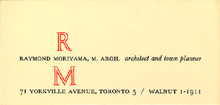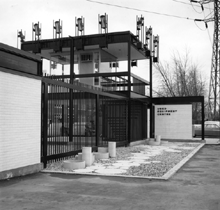|
|
||||||
|
: The Early Years : 32 Davenport Road : 30 Years at 32 : Changing Seasons : Credo For An Office : |
||||||

|
||||||

Raymond Moriyama's First Business Card
Crothers Used Equipment Gatehouse |
The Early Years - 1958 to 1965: On May 1, 1958, with $392.00 in the bank, Raymond Moriyama set up practice as a sole practitioner on the second floor of a semi-detached house at 71 Yorkville Avenue. Three rooms were shared with Klein and Sears Architects who started business on the very same day. Doors on saw horses became drafting boards. The firm's very first project was a cottage in Algonquin Park, designed for Mrs. Lazir. The project came in on budget: $8,000 including fees. Ray, his wife Sachi, and their three children stayed at the cottage for a week to make sure every detail was perfected. Two days after Ray opened his office, Joseph Crothers phoned with a commission for kitchen cupboards. A cheque for $1,000 arrived the next day. Joy! Over the following years a long-time relationship was formed with several members of the Crothers family, owners of a heavy equipment business. And numerous commissions followed, including the award-winning Halfway House and golf course, interior fit-up and exterior colour scheme for the Crothers' private airplane, and their much-published Used Equipment Centre, built of scrap iron. After a brief stay at 106 Yorkville Avenue (the renovated house is still there and is now occupied by a retail shop), the firm moved in 1961 to 711 Church Street. The basement space was divided into three rooms - reception/office, meeting room, and drafting room - which were shared with George Robb who designed the now demolished Shell Tower at the CNE. David Vickers, a student in a class at Ryerson taught by Ray, was the firm's first employee. Don Cooper, another student from Ryerson, soon was recruited as well. Ted Teshima was still an architecture student at U of T when he started helping out. Projects included a number of motels, Ford dealerships, more projects for the Crothers family, and, most important, the Japanese Canadian Cultural Centre. |
|||||

|
||||||
